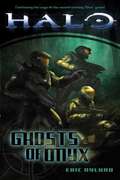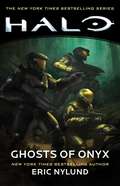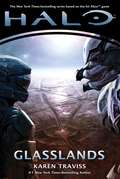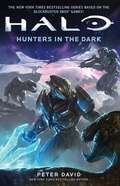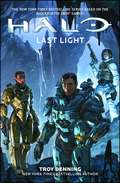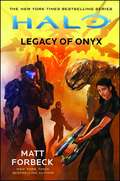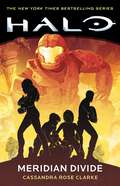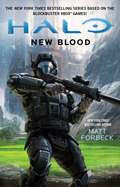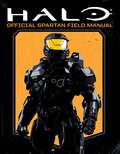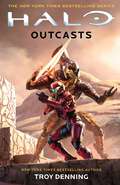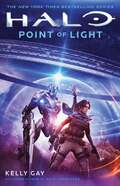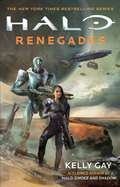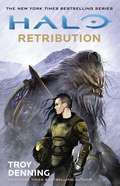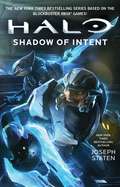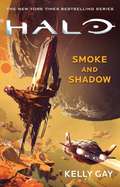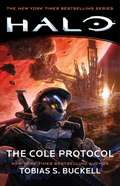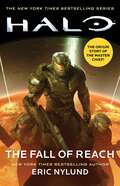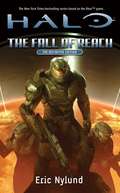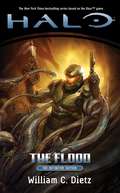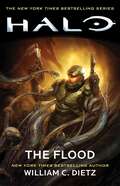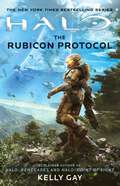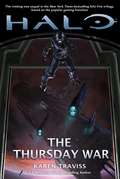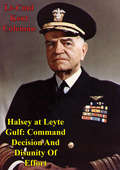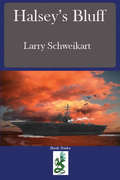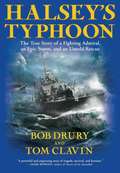- Table View
- List View
Halo: Ghosts of Onyx
by Eric NylundThe Spartan-II program has gone public. Tales of super-soldiers fending off thousands of Covenant attacks have become the stuff of legend. But just how many Spartans are left? While the Master Chief defends a besieged Earth, and the myriad factions of the Covenant continue their crusade to eliminate humanity, an ultrasecret cell of the Office of Naval Intelligence known as ,"Section Three ," devises a plan to buy the UNSC vital time. They're going to need hundreds of willing soldiers, though . . . and one more Spartan to get the job done. The planet Onyx is virtually abandoned and the perfect place to set this new plan in motion. But when the Master Chief destroys Halo, something is triggered deep within Onyx: Ancient Forerunner technology stirs, and fleets of UNSC and Covenant race to claim it to change the course of the Human-Covenant War. But this reawakened and ancient force may have plans of its own . . .
Halo: Ghosts of Onyx (Halo #4)
by Eric NylundThe New York Times bestseller—part of the expanded universe based on the award-winning video game series Halo!The twenty-sixth century. Once considered clandestine, the Spartan-II program has now gone public. Tales of armored super-soldiers fending off thousands of Covenant attacks have become the stuff of legend. While the Master Chief defends a besieged Earth, and the myriad factions of the Covenant continue their crusade to eliminate humanity, an ultra-secret cell of the Office of Naval Intelligence known as &“Section Three&” devises a plan to buy the UNSC vital time. It will need hundreds of willing soldiers, though—and one more Spartan—to get the job done. The planet Onyx is virtually abandoned and the perfect place to set this new plan in motion. But when the Master Chief destroys Halo, something is triggered deep within Onyx: Ancient Forerunner technology stirs, and fleets of UNSC and Covenant vessels race to claim it and change the course of the Human-Covenant War. But this reawakened and ancient force may have plans of its own…
Halo: Glasslands (Halo #1)
by Karen TravissThe Covenant has collapsed after a long, brutal war that saw billions slaughtered on Earth and her colonies. For the first time in decades, however, peace finally seems possible. But though the fighting's stopped, the war is far from over: it's just gone underground. The UNSC's feared and secretive Office of Naval Intelligence recruits Kilo-Five, a team of ODSTs, a Spartan, and a diabolical AI to accelerate the Sangheili insurrection. Meanwhile, the Arbiter, the defector turned leader of a broken Covenant, struggles to stave off civil war among his divided people. Across the galaxy, a woman thought to have died on Reach is actually very much alive. Chief scientist Dr. Catherine Halsey broke every law in the book to create the Spartans, and now she's broken some more to save them. Marooned with Chief Mendez and a Spartan team in a Forerunner slipspace bubble hidden in the destroyed planet Onyx, she finds that the shield world has been guarding an ancient secret - a treasure trove of Forerunner technology that will change everything for the UNSC and mankind. As Kilo-Five joins the hunt for Halsey, humanity's violent past begins to catch up with all of them as disgruntled colony Venezia has been biding its time to strike at Earth, and its most dangerous terrorist has an old, painful link with both Halsey and Kilo-Five that will test everyone's loyalty to the limit.
Halo: Hunters In The Dark (Halo #16)
by Peter DavidThe New York Times bestselling series based on the blockbuster video game for Xbox!It is 2555, more than two years after the Master Chief went missing-in-action following a decisive conflict on Installation 00—the massive, extragalactic Forerunner construct known as the Ark—as part of the final chapter in humanity&’s bloody thirty-year struggle against the overwhelming forces of the Covenant. Now, as a tenuous peace exists between the humans and the Elites, a startling scientific discovery is made…and the riddle behind its Forerunner origins could very well seal the fate of the entire galaxy within a matter of weeks. In order to unravel these dangerous secrets, a heroic, hastily formed coalition of humans and Elites must attempt to overcome their differences as they embark on a covert mission back to the Ark—an astonishing, enigmatic place beyond comprehension from which few have returned and where mortal danger awaits them all…
Halo: Last Light (Halo #17)
by Troy DenningAn original novel set in the Halo Universe and based on the New York Times bestselling video game series!It is 2553, and the three-decade long Covenant War that defined a generation has suddenly drawn to a close. Yet, in the remotest parts of human space, tensions remain that threaten to overflow into another full-scale conflict. Beneath the surface of the planet Gao lies a vast cavern system renowned for its therapeutic effects and rumored miraculous cures. But now Gao natives are turning up brutally murdered down there—violent acts that happen to coincide with the recent arrival of a UNSC research battalion protected by Spartan Blue Team, led by the renowned Spartan-II Fred-104. Maverick detective Veta Lopis of the Gao Ministry of Protection is only trying to do her job as the Special Inspector assigned to catch a serial killer—one who is possibly hiding within the Spartan ranks—but she never anticipates the situation spiraling out of control into an all-out crisis. When Gao is revealed to harbor ancient Forerunner technology that could solidify the UNSC’s military supremacy for centuries to come, Insurrection loyalists within the planetary government will do anything—even align with a vicious faction of what remains of the Covenant—to ensure that never happens…
Halo: Legacy of Onyx (Halo #22)
by Matt ForbeckAn original full-length novel set in the Halo universe and based on the New York Times bestselling video game series!Molly Patel was only seven-years-old when the alien alliance known as the Covenant destroyed her homeworld and killed her family. As one of the few to escape the glassing of Paris IV, and despite the United Nations Space Command winning the war on behalf of humanity, Molly never forgot how much she had lost. Nine years later, when her adoptive parents—research scientists specializing in ancient Forerunner technology—are called to the mysterious and wondrous place known as Onyx, Molly vehemently objects. It&’s not so much that Molly&’s concerned about relocating to inside a spherical construct the diameter of an entire solar system, but the fact that she also has to live alongside members of the same alien species that murdered her family. And when the Servants of the Abiding Truth—a violent ex-Covenant sect under the guidance of the notorious Pale Blade—somehow makes its way inside this supposedly impregnable sphere, Molly is now forced to consider if she and her new parents have made a terrible and fatal mistake in coming here....
Halo: Meridian Divide (Halo #2)
by Cassandra Rose ClarkeDiscover the original novel set in the Halo universe, based on the New York Times bestselling video game series!It&’s been three months since the colony world of Meridian was invaded by the alien theocratic alliance known as the Covenant. Under the close watch of the military, teenagers Evie, Dorian, Saskia, and Victor have been put into an accelerated training program with ONI, the Office of Naval Intelligence. And to the quartet&’s surprise, ONI has a mission for them: return to their hometown on Meridian and monitor the Covenant&’s efforts to retrieve an ancient Forerunner artifact of untold power. But what seems like a simple job quickly spirals out of their control. With the artifact at risk of falling into Covenant hands, the stakes are raised, and ONI tasks the teens and their team of militia fighters with extracting the artifact for study. After a series of missteps with command, the group must take matters into their own hand, journeying far behind enemy lines and into the heart of the war zones on a ravaged Meridian.
Halo: New Blood (Halo #15)
by Matt ForbeckThe New York Times bestselling series based on the blockbuster Xbox® games continues with the acclaimed story of Spartan Edward Buck—first seen in HALO: ODST and reappearing in HALO 5: GUARDIANS!While Spartans get all the glory, no soldier―not even the legendary Master Chief―wins a war on his own. Gunnery Sergeant Edward Buck and his team of Orbital Drop Shock Troopers (ODSTs) played a major role in saving Earth from all-out invasion at the end of the Covenant War―acts of bravery and ingenuity that did not go unnoticed by the United Nations Space Command. Now, after many Spartans have been killed in battle and the Master Chief is listed as MIA, the UNSC decides to create a new generation of Spartans to defend humanity from threats both outside―and within. When they come to Buck with an extraordinary proposition, he is forced to make a life-altering decision. With the Covenant War finally over, is it time for him to retire to the sidelines for a life he could only dream about…or is he prepared to step up and become part of the military’s new blood? Copyright © 2015 by Microsoft Corporation. All Rights Reserved. Microsoft, Halo, the Halo logo, Xbox, and the Xbox logo are trademarks of the Microsoft group of companies.
Halo: Official Spartan Field Manual (Halo)
by Kiel Phegley Kenneth PetersNow Halo fans of all ages can join the ranks of the most powerful super-soldiers in the galaxy with this in-world military handbook based on the bestselling video game series!Spartans. Humanity&’s first—and last—line of defense in a hostile 26th-century galaxy. You have been selected to join their ranks. The Official Spartan Field Manual is a guide to every element of the United Nations Space Command (UNSC) SPARTAN-IV program, disseminated to all newly augmented Spartans. Inside these pages is the guidance you&’ll need to put your enhanced strength, speed, and skills to use in both War Games training simulations and, ultimately, joint combat operations. This manual is essential for getting to know the weapons and vehicles you will be using on the battlefield, as well as the allies and enemies you can expect to encounter.
Halo: Outcasts (Halo #31)
by Troy DenningAn original novel set in the Halo universe—based on the New York Times bestselling video game series!2559. Formerly one of the Covenant&’s greatest and most fearsome warriors, Arbiter Thel &‘Vadam is now allied with his former human enemies while deeply entrenched in leading the Sangheili people to a new era of unification. But his aspirations are under constant threat, whether by the dangerous, warring factions of rival Sangheili keeps, or the relentless shadow of oppression spread by the renegade artificial intelligence Cortana. An opportunity to break Cortana&’s chains has suddenly presented itself through the rumored existence of an ancient artifact located on the hostile world of Netherop. Spartan Olympia Vale, trained with the skills to live and thrive among the Sangheili, also recognizes this alien prize as an essential means to aid humanity in reaching the same goal of freedom. But behind the scenes, both &‘Vadam and Vale are being manipulated by a mysterious figure with their own agenda. And to make matters worse, all involved are unknowingly placing themselves at perilous odds with forces beyond their comprehension…
Halo: Point of Light (Halo #28)
by Kelly GayAn original full-length novel set in the Halo universe and based on the New York Times bestselling video game series! August 2558. Rion Forge was once defined by her relentless quest for hope amidst the refuse and wreckage of a post-Covenant War galaxy—years spent searching for family as much as fortune. But that was before Rion and the crew of her salvager ship Ace of Spades encountered a powerful yet tragic being who forever altered their lives. This remnant from eons past, when the Forerunners once thrived, brought with it a revelation of ancient machinations and a shocking, brutal history. Unfortunately, the Ace crew also made dire enemies of the Office of Naval Intelligence in the process, with the constant threat of capture and incarceration a very real possibility. Now with tensions mounting and ONI forces closing in, Rion and her companions commit to this being&’s very personal mission, unlocking untold secrets and even deadlier threats that have been hidden away for centuries from an unsuspecting universe....
Halo: Renegades (Halo #25)
by Kelly GayAn original full-length novel set in the Halo universe and based on the New York Times bestselling video game series!Find. Claim. Profit. In a post-Covenant War galaxy littered with scrap, it&’s the salvager&’s motto—and Rion Forge certainly made her mark on the trade. All she wanted was to grow her business and continue the search for her long-lost father, but her recent discovery of a Forerunner debris field at the edge of human-occupied space has now put her squarely in the crosshairs of the Office of Naval Intelligence and the violent remains of the Covenant. Each faction has a desire to lay claim to the spoils of ancient technology, whatever the cost, sending Rion and the crew of the Ace of Spades on a perilous venture—one that unexpectedly leads them straight into danger far greater than anything they&’ve ever encountered…
Halo: Retribution (Halo #21)
by Troy DenningAn original full-length novel set in the Halo universe and based on the New York Times bestselling video game series!December 2553. Less than a year after the end of the Covenant War, a string of violent incidents continues to threaten the tenuous peace in human-held space, culminating in the assassination of UNSC fleet admiral Graselyn Tuwa and the abduction of her family. It is a provocation so outrageous that the Office of Naval Intelligence must retaliate swiftly and ferociously—but only after its operatives identify her killer and rescue the hostages. This mission will be the first for homicide-detective-turned-ONI-operative Veta Lopis and her young team of Spartan-IIIs, and something feels wrong from the start. The obvious suspect is an infamous Brute dokab who leads the Keepers of the One Freedom, a Covenant splinter group in fierce opposition to the UNSC. But Lopis and her team soon realize that the truth is much more insidious than they could ever have imagined, and along with Fred-104, Kelly-087, and Linda-058 of Blue Team for combat support, must stop a plan hatched in the bowels of the secret research station Argent Moon—a plan so sinister it could destroy all those still reeling from thirty years of intergalactic conflict...
Halo: Shadow of Intent (Halo)
by Joseph StatenAn original digital-first e-novella set in the Halo Universe and based on the New York Times bestselling video game series!After decades of grim combat against the humans and then the traitorous Covenant Prophets, the Sangheili warrior Rtas ‘Vadum—the Half-Jaw—has earned a long rest. But not all of the Prophets perished in their holy city, High Charity, and now one of their fearsome Prelates has sworn his vengeance. This powerful threat has set a cataclysmic plan in motion—a plan to lure the Half-Jaw into a trap that will herald the utter destruction of the entire Sangheili race…
Halo: Smoke and Shadow (Halo #19)
by Kelly GayAn original digital-first enovella set in the Halo Universe and based on the New York Times bestselling video game series!Find. Claim. Profit. In a post-war galaxy littered with scrap, it’s the salvager’s motto. And with a fast ship and a lust for adventure, Rion Forge has certainly made her mark on the trade. When the discovery of a wrecked UNSC cruiser brings Rion’s past back to haunt her, stirring fresh hope into a decades-old wound, she’s hell-bent on finding answers: What really happened to her father and his ship, the Spirit of Fire? This digital-first enovella also contains the complete text of Kelly Gay's short story “Into the Fire,” originally featured in the collection Halo: Fractures.
Halo: The Cole Protocol (Halo #6)
by Tobias S. BuckellThe New York Times bestseller—part of the expanded universe based on the award-winning video game series Halo!2535. It is the first, desperate days of the Human-Covenant War, and the United Nations Space Command has enacted &“the Cole Protocol&” to safeguard Earth and its inner colonies from discovery by its merciless alien foe. Many are called upon to rid the galaxy of lingering navigation data that could potentially reveal the location of Earth and ensure the destruction of humanity. Among those tasked with eliminating any trace of such dangerous information is Navy Lieutenant Jacob Keyes—now saddled with a top-secret mission by the Office of Naval Intelligence…one that will take him to a corner of the galaxy where nothing is as it seems. Out beyond the Outer Colonies lies the planet Hesiod, a gas giant surrounded by a vast asteroid belt. As the Covenant continues to glass the human-occupied planets near Hesiod, many of the survivors, aided by a stronghold of human insurrectionists, are fleeing to the asteroids for refuge. They have transformed the tumbling satellites into a tenuous yet ingenious settlement known as the Rubble—and have come face-to-face with a Covenant settlement of Kig-Yar…yet somehow survived. News of this unlikely treaty has spread to the warring factions. Luckily for the UNSC, this uneasy alliance is in the path of the Spartan Gray Team, a three-person renegade squad whose simple task is to wreak havoc from behind enemy lines in any way they see fit. But the Prophets have also sent their very best—an ambitious and ruthless Elite whose quest for nobility and rank is matched only by his brutality…
Halo: The Fall Of Reach (Halo #1)
by Eric NylundThe New York Times bestselling origin story of the Master Chief—part of the expanded universe based on the award-winning video game series Halo!The twenty-sixth century. Humanity has expanded beyond Earth&’s system to hundreds of planets that colonists now call home. But the United Earth Government and the United Nations Space Command is struggling to control this vast empire. After exhausting all strategies to keep seething colonial insurrections from exploding into a full-blown interplanetary civil war, the UNSC has one last hope. At the Office of Naval Intelligence, Dr. Catherine Halsey has been hard at work on a top-secret program that could bring an end to the conflict…and it starts with seventy-five children, among them a six-year-old boy named John. And Halsey could never guess that this child will eventually become the final hope against an even greater peril engulfing the galaxy—the inexorable confrontation with a theocratic military alliance of alien races known as the Covenant. This is the electrifying origin story of Spartan John-117—the Master Chief—and of his legendary, unstoppable heroism in leading the resistance against humanity&’s possible extinction.
Halo: The Fall of Reach
by Eric NylundThis definitive edition of the first and bestselling Halo novel, newly edited and updated, tells the story of the planet Reach. Within the pages of The Fall of Reach lies the origin of the Spartan II program and its greatest champion, the Spartan known as John-117, aka Master Chief. It's the epic story of how he, along with a very select group of candidates, was chosen to begin training at just the age of six to become part of the elite group of super soldiers known as the Spartans. Follow the Spartans as they embark on an epic battle for humanity's survival against the vast alien juggernaut known as the Covenant.
Halo: The Flood (Halo #2)
by William C. Dietz<p>Having barely escaped the battle for Reach, the crew of the Pillar of Autumn is forced to make a jump into Slipspace in hopes of evading the vast alien alliance hell-bent on wiping out humanity. But their destination brings them to an ancient mystery and an even greater struggle. <p>In this far-flung corner of the universe floats a magnificently massive artificial ring world…a construct from a long lost race. The humans' only hope of survival is to crash-land on its surface and take the battle against the Covenant to the ground. <p>But they soon discover that this enigmatic ring world is much more than it seems. Built 100,000 years ago by a civilization known as the Forerunners, this "Halo" is worshipped by the Covenant―a sacred artifact that they hope will complete their religious quest for supposed transcendence. They will stop at nothing to control it. <p>Engaged in a fierce ground battle, Master Chief and Cortana go deep into the Halo Construct to uncover a dark secret; this enigmatic ring world is also the universe's most dangerous weapon. Its purpose: the destruction of all sentient life. For the Forerunners built the Halo to battle the universe's most vicious enemy―a virtually unstoppable and suddenly reawakened force known as The Flood.</p>
Halo: The Flood (Halo #2)
by William C. DietzThe bestselling adaptation of the iconic video game Halo: Combat Evolved featuring the Master Chief—part of the expanded universe based on the award-winning video game series!2552. Having barely escaped the final battle for Reach against the vast alien alliance known as the Covenant, the crew of the Pillar of Autumn, including Spartan John-117—the Master Chief—and his AI companion Cortana, is forced to make a desperate escape into slipspace. But their destination brings them to an ancient mystery and an even greater struggle. In this far-flung corner of the universe floats a magnificently massive, artificial ringworld. The crew&’s only hope of survival is to crash-land on its surface and take the battle opposing the Covenant to the ground. But they soon discover that this enigmatic ringworld is much more than it seems. Built one hundred thousand years ago by a long-lost civilization known as the Forerunners, this &“Halo&” is worshipped by the Covenant—a sacred artifact they hope will complete their religious quest for supposed transcendence, and they will stop at nothing to control it. Engaging in fierce combat, Master Chief and Cortana will go deep into the Halo construct and uncover its dark secret and true purpose—even as a monstrous and far more vicious enemy than the Covenant emerges to threaten all sentient life on Halo and the galaxy beyond…
Halo: The Rubicon Protocol (Halo #30)
by Kelly GayUSA TODAY BESTSELLER An original novel set in the Halo universe—based on the New York Times bestselling video game series! A HALO INFINITE STORY December 2559. Humanity has its back against the wall after the United Nations Space Command flagship Infinity drops out of slipspace into a devastating ambush launched by the Banished. As this fierce enemy alliance seeks to claim a mysterious object hidden within the ancient Forerunner construct known as Zeta Halo, the surviving UNSC corps finds itself compromised and its leadership out of reach—with remaining personnel forced to abandon ship and take their chances on the fractured, unpredictable surface of the Halo ring. Now survival in this strange, alien environment—whether for Spartan super-soldiers or those who never thought they would see the battle up close—is measured day to day against a relentless and brutal adversary that always has the upper hand. Desperation grows, but the will to keep on fighting and enduring no matter the odds is never in doubt…even as the Banished seek to unleash a frightening new enemy that could doom them all…
Halo: The Thursday War (Halo #2)
by Karen TravissWelcome to humanity's new war: silent, high stakes, and unseen. This is a life-or-death mission for ONI's black-ops team, Kilo-Five, which is tasked with preventing the ruthless Elites, once the military leaders of the Covenant, from regrouping and threatening humankind again. What began as a routine dirty-tricks operation--keeping the Elites busy with their own insurrection--turns into a desperate bid to extract one member of Kilo-Five from the seething heart of an alien civil war. But troubles never come singly for Kilo-Five. Colonial terrorism is once again surfacing on one of the worlds that survived the war against the Covenant, and the man behind it is much more than just a name to Spartan-010. Meanwhile, the treasure trove of Forerunner technology recovered from the shield world of Onyx is being put to work while a kidnapped Elite plots vengeance on the humans he fears will bring his people to the brink of destruction.
Halsey At Leyte Gulf: Command Decision And Disunity Of Effort
by Lt-Cmd Kent Stephen ColemanIn October 1944, US forces executed amphibious landings on the Japanese-occupied island of Leyte in the central Philippines. Japanese naval forces, severely outnumbered by the US Third and Seventh Fleets, attempted to stop the invasion by attacking US amphibious shipping in Leyte Gulf. Due to the divided US area commands in the Pacific theater during World War II, the Third and Seventh Fleet commanders, Adm. Halsey and Vice Adm. Kinkaid, reported to separate superiors, Adm. Nimitz and Gen. MacArthur, even though both fleets were supporting the operation. Although the Japanese were soundly defeated, one of the Japanese forces, under Vice Adm. Kurita, nearly reached its objective. Many historians have criticized Halsey for ordering his carrier force to close with a Japanese carrier force that was acting as a decoy, thus leaving the US forces in Leyte Gulf unprotected. Although Halsey was effectively decoyed, the divided US naval chain of command amplified problems in communication and coordination between Halsey and Kinkaid. This divided command was more important in determining the course of the battle than the tactical decision made by Halsey and led to an American disunity of effort that nearly allowed Kurita's mission to succeed.
Halsey's Bluff
by Larry SchweikertAn alternative history of the battle of Midway. Admiral Halsey uses all his guile to protect the American fleet and turn the tide in the Pacific
Halsey's Typhoon: The True Story of a Fighting Admiral, an Epic Storm, and an Untold Rescue
by Bob Drury Tom ClavinIn the tradition of The Perfect Storm and Flags of Our Fathers , Halsey’s Typhoon chronicles the epic tale of men clashing against the ruthless forces of war and nature. In December 1944, America’s most popular and colorful naval hero, Admiral William “Bull” Halsey, unwittingly sailed his undefeated Pacific Fleet into the teeth of the most powerful storm on earth. Three destroyers were capsized sending hundreds of sailors and officers into the raging, shark infested waters. Over the next sixty hours, small bands of survivors fought seventy-foot waves, exhaustion, and dehydration to await rescue at the hands of the courageous Lt. Com. Henry Lee Plage, who, defying orders, sailed his tiny destroyer escort USS Tabberer through 150 mph winds to reach the lost men. Thanks to documents that have been declassified after sixty years and dozens of first-hand accounts from survivors—including former President Gerald Ford—one of the greatest World War II stories, and a riveting tale of survival at sea, can finally be told. Image descriptions added.
